
The Shrine Auditorium is a landmark large-event venue in Los Angeles, California. It is also the headquarters of the Al Malaikah Temple, a division of the Shriners. It was designated a Los Angeles Historic-Cultural Monument in 1975, and was added to the National Register of Historic Places in 1987.

The Alabama Theatre is a movie palace in Birmingham, Alabama. It was built in 1927 by Paramount's Publix Theatre chain as its flagship theater for the southeastern region of the United States. Seating 2,500 people at the time, it was the largest in the Birmingham Theatre district. The district was once home to a myriad of large theaters that featured vaudeville, performing arts, nickelodeons, and large first-run movie palaces. The Alabama is the only district theater still operating today. Built to show silent films, the Alabama still features its original Wurlitzer theater organ. Other than the Alabama, the Lyric Theatre is the only theater still standing in the district.
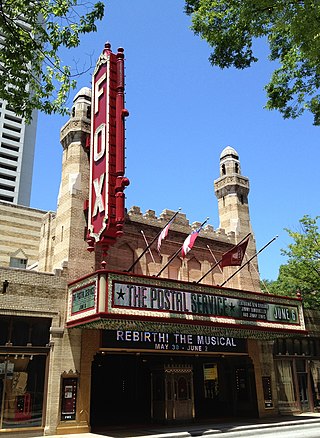
The Fox Theatre, a former movie palace, is a performing arts venue located at 660 Peachtree Street NE in Midtown Atlanta, Georgia, and is the centerpiece of the Fox Theatre Historic District.

The Fox Theatre is a performing arts center located at 2211 Woodward Avenue in Downtown Detroit, Michigan, near the Grand Circus Park Historic District. Opened in 1928 as a flagship movie palace in the Fox Theatres chain, it was at over 5,000 seats the largest theater in the city. Designed by theater architect C. Howard Crane, it was listed on the National Register of Historic Places in 1985.

Jim Whelan Boardwalk Hall, formerly known as the Historic Atlantic City Convention Hall, is a multi-purpose arena in Atlantic City in Atlantic County, New Jersey. It was Atlantic City's primary convention center until the opening of the Atlantic City Convention Center in 1997. Boardwalk Hall was declared a U.S. National Historic Landmark in 1987 as one of the few surviving buildings from the city's early heyday as a seaside resort. The venue seats 10,500 people for ice hockey, and at maximum capacity can accommodate 14,770 for concerts. Boardwalk Hall is the home of the Miss America Pageant.
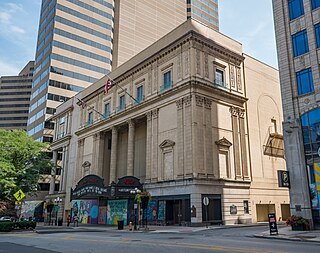
The Ohio Theatre is a performing arts center and former movie palace on Capitol Square in Downtown Columbus, Ohio. Known as the "Official Theatre of the State of Ohio", the 1928 building was saved from demolition in 1969 and was later completely restored. The theater was declared a National Historic Landmark in 1977 as one of the nation's finest surviving grand theaters.
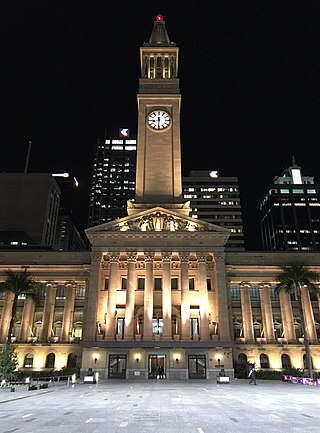
Brisbane City Hall, in Brisbane, Queensland, Australia, is the seat of the Brisbane City Council. It is located adjacent to King George Square, where the rectangular City Hall has its main entrance. The City Hall also has frontages and entrances in both Ann Street and Adelaide Street. The building design is based on a combination of the Roman Pantheon, and St Mark's Campanile in Venice and is considered one of Brisbane's finest buildings. It was listed on the Register of the National Estate in 1978 and on the Queensland Heritage Register in 1992. It is also iconic for its Westminster chimes which sound on the quarter-hour.
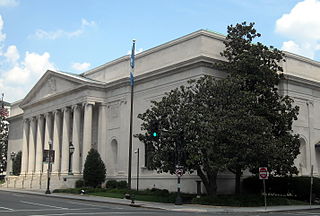
DAR Constitution Hall is a concert hall located at 1776 D Street NW, near the White House in Washington, D.C. It was built in 1929 by the Daughters of the American Revolution to house its annual convention when membership delegations outgrew Memorial Continental Hall. Later, the two buildings were connected by a third structure housing the DAR Museum, administrative offices, and genealogical library. DAR Constitution Hall is still owned and operated by the National Society of Daughters of the American Revolution. It was designated a National Historic Landmark in 1985. It has been a major cultural center of the city since its construction, and houses its largest auditorium.

The Jefferson Theatre is a historic performing arts theatre located on Fannin Street in downtown Beaumont, Texas. Designed by Emile Weil and built in 1927, it is an example of Old Spanish architecture and seats over 1400. The theatre was built by Jefferson Amusement Company, which was owned by Saenger Amusements. The theatre is featured on the National Register of Historic Places and recognized as a Recorded Texas Historic Landmark. The theatre recently underwent a comprehensive multimillion-dollar renovation. It is also one of the few theatres in the country containing its original Morton organ, produced by the Robert Morton Organ Company.
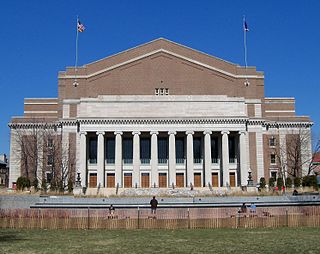
Cyrus Northrop Memorial Auditorium is a performing arts venue at the University of Minnesota in Minneapolis, Minnesota. It is named in honor of Cyrus Northrop, the university's second president. Various events are held within the building, including concerts, ballet performances, lectures, and graduations.
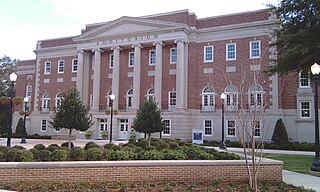
Foster Auditorium is a multi-purpose facility at the University of Alabama in Tuscaloosa, Alabama. It was built in 1939 as a Works Progress Administration project and has been used for Alabama basketball, women's sports, graduations, lectures, concerts, and other large gatherings, including registration. Its status as the largest indoor building on campus came to an end in 1968 with the opening of the Memorial Coliseum. The building housed the Department of Kinesiology until 2006. In April 2009, the University announced a major renovation for the auditorium. After the renovation, the Crimson Tide women's basketball and volleyball programs moved back to Foster Auditorium, their original home.

The Dalles Civic Auditorium is a historic building on the National Register of Historic Places located at the corner of Fourth and Federal streets in The Dalles, Oregon. It is currently owned by the Civic Auditorium Historic Preservation Committee, a non-profit corporation formed specifically for the purpose of purchasing it from the City of The Dalles to save it from scheduled demolition, restore it, and operate it as a local and regional cultural center.

Jesse Hall is the main administration building for the University of Missouri. Its dome has towered 180 feet above the south end of David R. Francis Quadrangle since its completion in 1895. In the lawn in front of Jesse Hall are The Columns, all that remains of its predecessor Academic Hall, which burned in 1892. The building contains the office of the chancellor, university registrar, graduate school, admissions, and financial aid. One of the most photographic landmarks in Missouri, the building was designed by Missouri architect Morris Frederick Bell, and is his largest surviving work. Jesse Auditorium had hosted graduations and many university functions over the years. The University Concert Series presents national and international concerts, Broadway shows, performers, bands, speakers, and theater to the largest auditorium in Columbia. As the former home of the School of Music, student performances occasionally happen. The building is the most prominent contributing structure to the David R. Francis Quadrangle National Register of Historic Places District. In 1922 "New Academic Hall" became "Jesse Hall" in honor of retiring University President Richard Henry Jesse.

Veterans Memorial Auditorium is a performing arts theater in Providence, Rhode Island. Construction began in 1928 but was delayed by the Great Depression. The theater was finally completed in 1950. The adjacent Performing Arts Complex was erected in 1970 and is partially owned by the Veterans' Memorial Foundation.
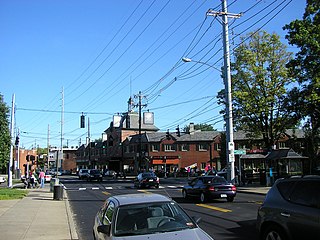
The Schuster Building is a mixed-use structure at the intersection of Bardstown Road and Eastern Parkway in the Highlands area of Louisville, Kentucky. Added to the National Register of Historic Places in 1980 as a "significant example" of Colonial Revival architecture as applied to commercial buildings, the Schuster building is one of Louisville's most prominent examples of that style.

Crouse College, also known as Crouse Memorial College and historically as John Crouse Memorial College for Women, is a building on the Syracuse University campus. It was funded by John R. Crouse, a wealthy Syracuse merchant with the White family, and designed by Archimedes Russell. It is built in the Romanesque revival—Richardsonian Romanesque style.
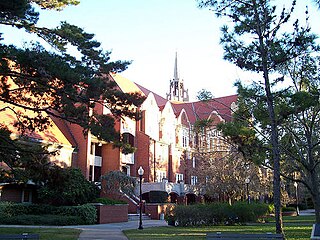
The University Auditorium, originally known as the Memorial Auditorium and sometimes called the University of Florida Auditorium, is a historic building on the campus of the University of Florida in Gainesville, Florida, in the United States. It was designed by William Augustus Edwards in the Collegiate Gothic style and was built between 1922-1924. It was restored and expanded in 1977 by architect James McGinley. The expansion, which added a new entrance and lobbies, was designed to complement but not match the original architecture. It is a contributing property in the University of Florida Campus Historic District which was added to the National Register of Historic Places on April 20, 1989. On April 18, 2012, the AIA's Florida Chapter placed University Auditorium on its list of Florida Architecture: 100 Years. 100 Places.

The Louisville and Nashville Railroad Office Building, at 908 W. Broadway in downtown Louisville, Kentucky, is a historic skyscraper building, built in 1907, which is listed on the National Register of Historic Places. It was once the headquarters of the Louisville and Nashville Railroad, a prominent railroad company from the mid-19th century to the 1970s.

Shreveport Municipal Memorial Auditorium is a historic performance and meeting venue at 705 Elvis Presley Boulevard in Shreveport, Louisiana. It is an Art Deco building constructed between 1926 and 1929 during the administration of Mayor Lee Emmett Thomas as a memorial to the servicemen of World War I. In 1991, the auditorium was listed on the National Register of Historic Places and on October 6, 2008, it was designated a National Historic Landmark.

The Heritage, formerly known as the Journal Record Building, Law Journal Record Building, Masonic Temple and the India Temple Shrine Building, is a Neoclassical building in Oklahoma City, Oklahoma. It was completed in 1923 and listed on the National Register of Historic Places in 1980. It was damaged in the 1995 Oklahoma City bombing. It houses the Oklahoma City National Memorial Museum in the western 1/3 of the building and The Heritage, a class A alternative office space, in the remaining portion of the building.























